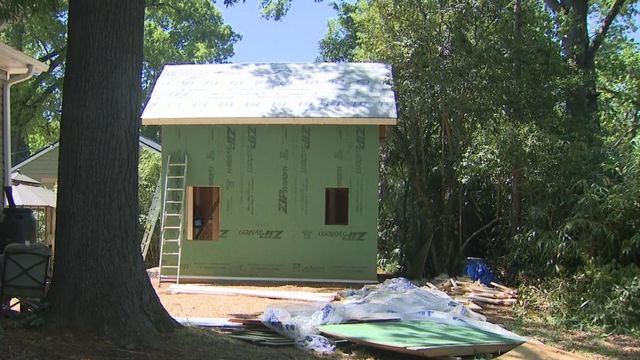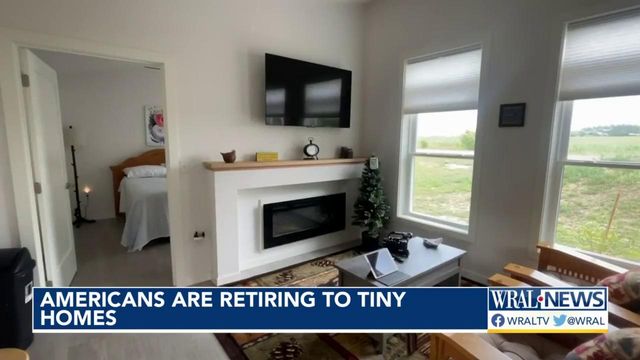The truth behind the tiny homes some major retailers are offering
Home Depot, Amazon and other retailers have added kit homes to their wide list of offerings on their websites.
Some of these are advertised as "DIY" projects and have notes in the descriptions like "easy-to-install," but if you're not careful you could quickly find yourself in over your head on one of these builds.
Prices range from around $20,000 and up for these kit homes, but what's included varies widely. Some are just frames, others include enough to enclose the house, and there are prefabricated options that are more complete.
It's reminiscent of what Sears Roebuck did in the early twentieth century. Back then, you could pick a home out of a catalog, then have all the precut lumber and assembly materials shipped to you to build.
Sears Archives says more than 100,000 houses were sold through Sears's Modern Homes Program from 1908 to 1940. Some are still in use in Raleigh today.
The kit homes for sale these days don't include as much as you got from the Sears kits of a century ago.
Vail Gardner considered Home Depot's tiny home kit when she decided to add a second home on her Durham Property.
"The shell looks very inexpensive on the screen and then you start thinking about fixtures and sinks and toilets and cabinets and faucets; and by the time you add all that up, it wasn’t any less expensive than having someone build it," Gardner said.
Instead, she hired Coram Houses and Topher Thomas to build a tiny home from the ground up.
"When I looked at what I wanted to do to build it and started going down the kit road," Gardner said, "it's much more expensive than what it is on the website. In some cases, double or triple once you add it all in."
Thomas's first tiny house build was in his own backyard. He went on to start a company building them in other people's backyards to create affordable rental spaces.
"As real estate in the Triangle was going up, you had people being displaced and usually they couldn’t go anywhere in the city they had to go somewhere else. So, by having Accessory Dwelling Units that are going to be smaller and cheaper you create this asset class almost of naturally occurring affordable housing," Thomas said to 5 On Your Side.
"It's exciting to me that there's going to be more affordable housing," Gardner told us.
Just about a mile down the road, Robin Davis is also having a tiny house built on her property.
"Yes it is tiny, it is; but I think it's efficient," Davis said.
The tiny home under construction in her side yard will soon become a rental unit for homeless veterans with help from HUD's Veterans Affairs Supportive Housing program.
Davis told 5 On Your Side her daughter, brother and late husband all served, and she knows how much a rental option, like the one she's building, can do for a veteran who is struggling.
"It would mean a great deal to them. I think it's an awesome program," Davis said about the VASH-program.
Over in Raleigh, there have been 187 ADU applications in the city since 2021 with nearly half of them already completed.
Jennifer Truman advocated for updated regulations on ADUs and tiny homes in Raleigh and is also a residential designer.
"The numbers really show that because we have such housing demand that people want this as an option," Truman said.
With tiny homes getting more popular, retailers are jumping into this space. A 346-square foot kit house on Home Depot's website sells for $54,000 which sounds attractive, but doesn’t include some of the most expensive parts.
"You've got to connect it to the ground with the foundation, you’ve got to connect it to water and sewer, you’ve got to connect it to electricity and all of those things are actually the really expensive parts of the building," Truman said.
Add in finishings and it could easily double or triple the list price, similar to what Gardner found in her research.
Because parts of the kit come preassembled, like the walls; you have to be sure they meet local building code.
"They're gonna promise you that it's turnkey even if they’ve never built in your city before," Truman said. "You do run that risk that they may not have the local knowledge."
Both Truman and Thomas said the kits aren't bad options and they could end up saving you money if you are going to do most of the work.
"It's not an obscene or crazy amount of work but if you think you're just gonna go to Home Depot and click order and 'oh I got a house.' It's like no you have a shell and then you have like hours and hours and months of months of coordination work to do," Thomas explained.
A homeowner is allowed to build their own ADU, but there is a question about whether you can rent it out if you build it yourself. It's critical to check with your local code enforcement department on that first.












